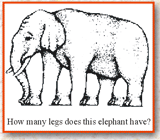Vertigo is not a disease. It is a symptom of any one of
a number of underlying diseases. So large is the number indeed
that many GP's may truly have despaired about finding a cause.
The grey areas in the aetiology of vertigo are more numerous
than the clearly identifiable causes.
THREE SETS OF SENSORS
The ability of normal people to orient themselves
in space depends on information from three sets of sensors.
First and most obviously, information about the body's position
and orientation comes from the eyes. Second is a set of similar
information arising from the body muscles the muscle sensors
being known as proprioceptors. And finally, there is the information
input about balance which comes from the balance receptors
in the inner ear.
For any individual to be able to orient himself and move effectively,
two of these sensing systems must remain functional. The partial
impairment of two of these systems may have a similar effect
to the almost total absence of one.
Hence, the complex system includes the following:
The vestibular labyrinth(semi-circular canals and utricle).
- VIII cranial nerve.
- The brain stem.
- The eyes.
- The proprioceptive system.
- The median longitudinal fasciculus(midbrain to temporallobe).
- The vestibulo-spinal tract (posterior columns).
- Central coordinating mechanism (cerebellum).

The examination of the patient should include the following
and physician must rule out psychiatric disturbances and functional
vertigo before evaluation of vertigo:
- BP in standing and supine position.
- Nystagmus (both spontaneous and induced).
- ENT exam, including audiogram, impedance and BERA.
- Cardiovascular system.
- Central nervous system.
- Haematology including serologic determination.
In conclusion, evaluation of the patient with vertigo must be done in a systematic way so that identification of the specific cause and management will be useful if the cause is identified.
“True diagnosis is three fourth of the treatment”
Mahatma Gandhi is perfectly correct in managing vertigo.